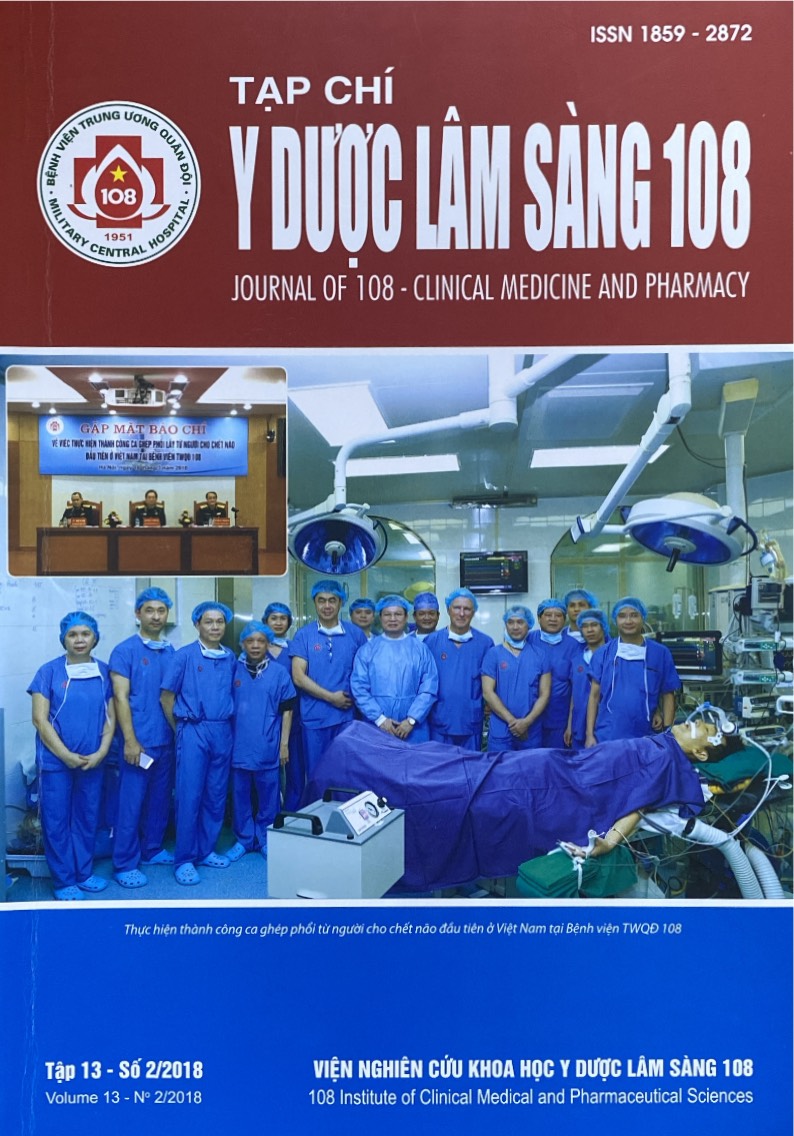Đặc điểm thể cơn nhịp nhanh trên thất giữa bệnh nhân trẻ tuổi và cao tuổi được thăm dò điện sinh lý học tim
Main Article Content
Keywords
Tóm tắt
Mục tiêu: Nhận xét về đặc điểm cơn nhịp nhanh trên thất ở bệnh nhân trẻ tuổi và cao tuổi được thăm dò điện sinh lý tim và mô tả các rối loạn nhịp tim khác trong cơn nhịp nhanh trên thất ở những bệnh nhân trên. Đối tượng và phương pháp: Nghiên cứu mô tả cắt ngang, tiến cứu theo trình tự, 186 bệnh nhân được chẩn đoán xác định cơn nhịp nhanh trên thất được tiến hành thăm dò điện sinh lý tim và điều trị bằng năng lượng sóng có tần số radio tại Viện Tim mạch Việt Nam trong thời gian từ tháng 01/2014 đến tháng 05/2017, được chia làm hai nhóm: Nhóm I là nhóm bệnh nhân trẻ tuổi (những bệnh nhân dưới 60 tuổi) & nhóm II là nhóm bệnh nhân cao tuổi (những bệnh nhân có tuổi ≥ 60). Kết quả: Nhóm I (nhóm trẻ tuổi) chiếm 51,1% và nhóm II (nhóm cao tuổi) chiếm 48,9%. Đặc điểm thể cơn nhịp nhanh trên thất có 68,3% là cơn vòng vào lại nút nhĩ thất, có 29,6% là cơn vòng vào lại nhĩ thất và 2,2% có cơn nhịp nhanh nhĩ và những cơn nhịp nhanh nhĩ đều gặp trên bệnh nhân có hội chứng Wolff-Parkinson-White, trong đó có 2 trường hợp kèm nhiều cơn rung nhĩ ngắn và 2 trường hợp kèm những cơn rung nhĩ bền bỉ. Tỷ lệ nữ giới có cơn nhịp nhanh trên thất là 69,4% cao hơn so với nam giới là 30,6%, trong đó tỷ lệ nữ giới có cơn vòng vào lại nút nhĩ thất và cơn vòng vào lại nhĩ thất lần lượt là 74,8% và 61,8%. Chỉ có 9,8% có biểu hiện hội chứng Wolff-Parkinson-White trên điện tâm đồ. Khi thăm dò điện sinh lý tim, tỷ lệ rung cuồng nhĩ xuất hiện ở 15,6% và tỷ lệ blốc nhánh gặp 5,9%, nhóm bệnh nhân cao tuổi có tỷ lệ rung cuồng nhĩ (24,2%) cao hơn nhóm trẻ tuổi (7,4%), với p<0,01. Kết luận: Cơn nhịp nhanh trên thất hay gặp ở nữ hơn nam, khả năng gặp loại cơn vòng vào lại nút nhĩ thất cao hơn so với cơn vòng vào lại nhĩ thất. Độ tuổi trung bình có cơn vòng vào lại nút nhĩ thất, cơn vòng vào lại nhĩ thất ở nhóm cao tuổi là lớn hơn ở nhóm trẻ tuổi. Tỷ lệ rung cuồng nhĩ khá hay gặp ở cơn nhịp nhanh trên thất và ở nhóm cao tuổi hay gặp hơn nhóm trẻ tuổi, hội chứng Wolff-Parkinson-White chiếm tỷ lệ đáng kể và điện tâm đồ ngoài cơn của bệnh nhân có cơn vòng vào lại nhĩ thất ở nhóm cao tuổi nhiều hơn nhóm trẻ tuổi.
Article Details
Các tài liệu tham khảo
2. Phan Đình Phong (2005) Nghiên cứu điện tâm đồ bề mặt và trong buồng tim của cơn tim nhanh vào lại nút nhĩ thất hoặc vào lại nhĩ thất. Luận văn tốt nghiệp bác sỹ nội trú bệnh viện, Trường Đại học Y Hà Nội.
3. Trần Song Giang (2012) Nghiên cứu đặc điểm điện sinh lý và điều trị nhịp nhanh do vòng vào lại nút nhĩ thất bằng năng lượng sóng có tần số radio. Luận án Tiến sỹ Y học, Trường Đại học Y Hà Nội.
4. Trần Thành Đạt và CS (2012) Khảo sát tình hình cơn nhịp nhanh kịch phát trên thất chẩn đoán - hướng xử trí tại Khoa Hồi sức cấp cứu - Bệnh viện Đa khoa Bà Rịa. Tạp chí Y học thực hành, số 1 năm 2012.
5. Trần Văn Đồng (2006) Nghiên cứu điện sinh lý tim và điều trị bệnh nhân có hội chứng Wolff-Parkinson-White bằng năng lượng có tần số radio. Luận án Tiến sỹ Y học, Học viện Quân y.
6. Bottoni N, Tomasi C, Donateo P et al (2003) Clinical and electrophysiological characteristics in patients with atrioventricular reentrant and atrioventricular nodal reentrant tachycardia. Europace 5(3): 225-229.
7. Canonico V, De CL, Vigorito C et al (1990) Differences in blood pressure profile between young and elderly hypertensive patients. J Hum Hypertens 4(4): 405-409.
8. Chen SA, Chiang SA, Yang CJ et al (1994) Accessory pathway and atrioventricular node reetrant tachycardia in elderly patients: Clinical features, electrophysiologic characteristics and results of radiofrequency ablation. J Am Coll Cardiol 23: 702-708.
9. De MM, Jacobs P, Haardt R, Englert M (1986) Variations of normal sinus node function in relation to age: Role of autonomic influence. Eur Heart J 7(8): 662-672.
10. Randall AC, Mitchell JS, Jay S et al (2010) Common types of supraventricular tachycardia: Diagnosis and management. American Family Physician 82(8): 942-952.
11. Stellbrink C, Diem B, Schauerte P et al (2001) Differential effects of atropine and isoproterenol on inducibility of atrioventricular nodal reentrant tachycardia. J Interv Card Electrophysiol 5(4): 463-469.
12. Yangni N’Da’ O, Brembilla-Perrot B (2008) Clinical characteristics and management of paroxysmal junctional tachycardia in the elderly. Archives of Cardiovascular Diseases 101(3): 143-148.
 ISSN: 1859 - 2872
ISSN: 1859 - 2872
